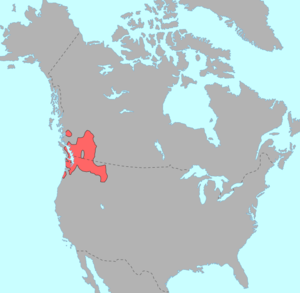
Back Llingües salishanas AST سالیش دیللری AZB Yezhoù salichek Breton Llengües salish Catalan Salish Danish Salish-Sprachen German Saliŝa lingvaro Esperanto Lenguas salishanas Spanish زبانهای سالیش Persian Langues salish French
This article includes a list of general references, but it lacks sufficient corresponding inline citations. (January 2015) |
| Salishan | |
|---|---|
| Salish | |
| Geographic distribution | Pacific Northwest and Interior Plateau/Columbia Plateau in Canada and the United States |
| Ethnicity | Salish peoples |
| Linguistic classification | One of the world's primary language families |
| Subdivisions | |
| Language codes | |
| ISO 639-2 / 5 | sal |
| Glottolog | sali1255 |
 Pre-contact distribution of Salishan languages (in red). | |
The Salishan (also Salish /ˈseɪlɪʃ/) languages are a family of languages of the Pacific Northwest in North America (the Canadian province of British Columbia and the American states of Washington, Oregon, Idaho and Montana).[1] They are characterised by agglutinativity and syllabic consonants. For instance the Nuxalk word clhp’xwlhtlhplhhskwts’ (IPA: [xɬpʼχʷɬtʰɬpʰɬːskʷʰt͡sʼ]), meaning "he had had [in his possession] a bunchberry plant",[2] has twelve obstruent consonants in a row with no phonetic or phonemic vowels.
The Salishan languages are a geographically contiguous block, with the exception of the Nuxalk (Bella Coola), in the Central Coast of British Columbia, and the extinct Tillamook language, to the south on the central coast of Oregon.
The terms Salish and Salishan are used interchangeably by linguists and anthropologists studying Salishan, but this is confusing in regular English usage. The name Salish or Selisch is the endonym of the Flathead Nation. Linguists later applied the name Salish to related languages in the Pacific Northwest. Many of the peoples do not have self-designations (autonyms) in their languages; they frequently have specific names for local dialects, as the local group was more important culturally than larger tribal relations.
All Salishan languages are considered critically endangered, some extremely so, with only three or four speakers left. Those languages considered extinct are often referred to as "dormant languages", in that no speakers exist currently, but still serve as a symbol of ethnic identity to an ethnic group. In the early 21st century, few Salish languages have more than 2,000 speakers. Fluent, daily speakers of almost all Salishan languages are generally over sixty years of age; many languages have only speakers over eighty.
Salishan languages are most commonly written using the Americanist phonetic notation to account for the various vowels and consonants that do not exist in most modern alphabets.[citation needed] Many groups have evolved their own distinctive uses of the Latin alphabet, however, such as the Saanich.
- ^ "First Nations Culture Areas Index". the Canadian Museum of Civilization.
- ^ Bagemihl, Bruce (1991). "Syllable Structure in Bella Coola". Linguistic Inquiry. 22 (4): 589–646. ISSN 0024-3892. JSTOR 4178744.